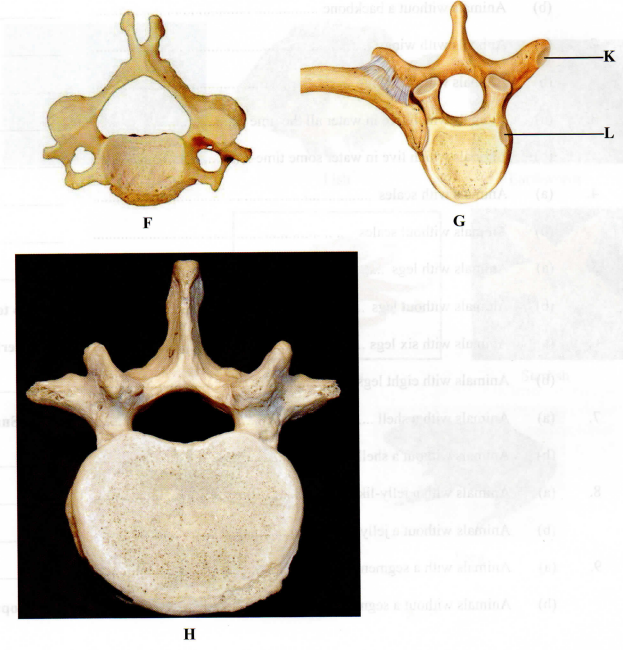- Using the pictures of animals provided below, complete the construction of the dichotomous key by filling the blank spaces. (13 marks)

-
- Animals with a backbone ............................ go to 2
- Animals without a backbone ........................
- Animals with a backbone ............................ go to 2
-
- Animals with wings ............................
- Animals without wings .......................
-
- Animals which live in water all the time............................
- Animals which live in water some time ............................
- Animals with scales.............................
- Animals without scales........................
-
- Animals with legs ............................
- Animals without legs ........................ go to 7
-
- Animals with six legs............................ Butterfly
- Animals with eight legs..........................
-
- Animals with a shell ............................ Snail
- Animals without a shell.........................
-
- Animals with a jelly-like body ............................
- Animals without a jelly-like body........................
-
- Animals with a segmented body ............................
- Animals without a segmented body ....................... Octopus
-
- Below are pictures of three mammalian vertebrae.

- Name the type of vertebra labeled
F ......... (1 mark)
G ......... (1 mark)
H .........(1 mark) - Label five parts of the vertebra labeled H. (5 marks)
- Name the articular facets labeled K and L.
K......... (1 mark)
L ......... (1 mark) - How does each of the parts of a vertebra enable a mammalian skeleton to carry out its functions? (4 marks)
- Name the type of vertebra labeled
- You are provided with a 250 ml beaker, four test tubes, solutions labeled D and E, iodine and Benedict’s solution.
Half fill the beaker with the hot water provided to create a hot water bath.- Label the four test tubes as follows:
- Test tube 1, D + iodine
- Test tube 2, D + E + iodine
- Test tube 3, D + Benedict’s solution
- Test tube 4, D + E + Benedict’s solution
- Put 1 cm3 of solution D in each of the four test tubes.
- To the solution D + Iodine test tube, add only one drop of iodine solution and shake to mix.
- To the D + E + Iodine test tube, add 1 cm3 of solution E and two drops of iodine solution and shake to mix.
- To the D + Benedict’s solution test tube, add 1 cm3 of Benedict’s solution and shake to mix.
- To the D + E + Benedict’s solution test tube, add 1 cm3 of solution E and 1 cm3 of Benedict’s solution. Shake to mix.
- Observe the changes in each of the four test tubes.
- Put all the four test tubes in the hot water bath and observe carefully for about five minutes.
- Record the observations and conclusion for each of the four test tubes in the table below. (8 marks)
NO TEST TUBE OBSERVATION CONCLUSION 1 D + Iodine 2 D + E + Iodine 3 D + Benedict's solution 4 D + E + Benedict's solution - What was the role of each of the following in the experiment?
- Solution E (1 mark)
- Hot water bath (1 mark)
- Give the identity of E in human beings. (1 mark)
- Explain the observation made on the reagents tested with Benedict’s solution. (1 mark)
- Label the four test tubes as follows:

MARKING SCHEME
-
- (b) go to 5;
-
- Eagle;
- go to 3;
-
- Fish;
- go to 4;
-
- Tortoise;
- Frog;
- go to 6;
- (b) Spider;
- (b) go to 8;
-
- go to 9;
- Starfish;
-
- Earthworm (13 marks)
-
- F Cervical/Cervical bone; (1 mark)
G Thoracic/Thoracic bone; (1 mark)
H Lumbar/Lumbar bone; (1 mark)
Labels 6/2 = 3 marks
Labels touching object = 1 mark
Labels not crossing = 1 mark
maximum = 5 marks- K - Tubercular (facet);
K - Capitular (facet); (2 marks) -
- (Large) centrum to support the body vertebrae;
- Neural arch to protect the spinal cord;
- (Extended) transverse processes for attachment of (abdominal) muscles;
- (Long) neural spine for attachment of abdominal muscles/ligaments;
- Facets for articulation with other vertebrae;
- Neural canal for passage of spinal cord (4 marks)
- F Cervical/Cervical bone; (1 mark)
-
(8 marks)NO. TEST TUBE OBSERVATION CONCLUSION 1 D+Iodine Turns blue black/blue/black: Starch present; 2 D+E+Iodine Turns colourless/blueblack colour disappears Starch absent/decreases; 3 D+Benedict's solution Remains blue/no colour change; Reducing sugars absent; 4 D+E+Benedict's solution Turns green, yellow, orange, blown/reddish blown Reducing sugars present; -
- Breaks down (hydrolyses) starch; into maltose/reducing sugar; (2 marks)
-
- Provides optimum suitable temperature; for activity of E/enzymes;
- Required when testing for reducing sugars using Benedict's solution;
- Activates enzymes.
- Salivary amylase or ptyalin/ amlyse/pancreatic amylase. (1 mark)
- Substance D tests negative with Benedict's solution because it is a complex/ polysaccharide; addition of E on heating gives positive results with Benedict's solution, since E hydrolyses, the starch/ complex sugar into simple sugars; testing positive.
OR
Starch in D/D is a non-reducing sugar/complex sugar/polysaccharide/not a reducing sugar, startch is hydrolysed/digested/broken down into reducing sugars by E/Amylase in E/Amylase/Diastase/enzyme in E. (2 marks)
Join our whatsapp group for latest updates
Tap Here to Download for 50/-
Get on WhatsApp for 50/-
Download KCSE 2015 Biology Paper 3 with Marking Scheme.
Tap Here to Download for 50/-
Get on WhatsApp for 50/-
Why download?
- ✔ To read offline at any time.
- ✔ To Print at your convenience
- ✔ Share Easily with Friends / Students


